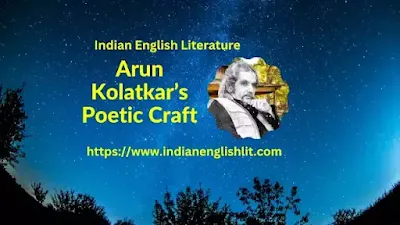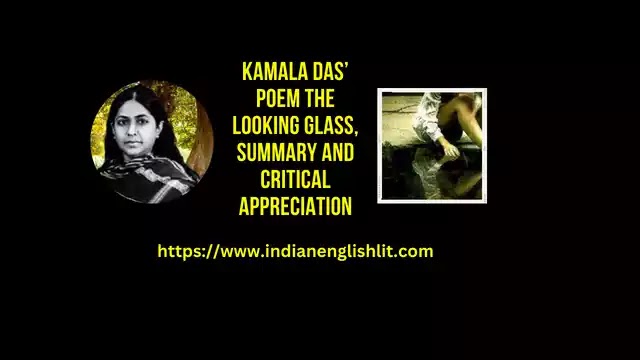Employment of Imagery in Kolatkar's Poetry:
The initial consideration in assessing the poetic craft of a writer is the kind of imagery which he supplies in connection with the exposition or elaboration of an idea. Imagery is an indispensable ingredient of poetry because it is imagery which lends solidity to an idea. Sometimes no doubt the imagery itself is very abstract and, in that case, it does not impart any concreteness to an idea though it may still serve as a clarification of the idea in philosophical language. Kolatkar's imagery is perfectly concrete except here and there.

Imagery in The Boatride:
The Boatride is a wholly visual poem. It contains a series of pictures, beginning from the very opening passage in which we are told about the long - hooked poles which know the nooks and crannies, which find flaws in stone - work or, grappling with granite, cause a batch of pigeons to fly away unexpectedly. The boat is then “jockeyed away” from the landing - place. Every stanza in this poem presents a picture and in fact, several pictures. In one of the stanzas, for instance, we first have the picture of a “mousy patriarch” (or a very timid old man) who is accompanied by a large group of grand - children to whom he delivers a discourse, urging them to be careful and not to fall into the water. This elaborate picture is followed by another which depicts the youngest child meditating over what the grandfather has said, while the eyes of the other children are riveted proudly to the Portuguese ship which, they have been told, was captured by the Indians (when they drove the Portuguese away from the small territories which the Portuguese had continued to occupy even after the British had departed). From the point of view of imagery, The Hag is also a noteworthy poem. It depicts an old, tottering woman eating, not eating but devouring, oranges of which she is extraordinary fond. This sketch of a hag, this vignette of a gluttonous woman, is simply unforgettable. Similarly the poem entitled Irani Restaurant Bombay contains plenty of imagery though it is otherwise a tough poem.
The Use of Proper and Appropriate Diction:
The most important consideration, so far as poetic technique is concerned, is the diction. After all, poetry is expression; poetry is statement; poetry is an unfolding and a revelation. And expression, statement etc., are possible only through the use of words. To what extent has a poet succeeded in expressing himself? What kind of words has he used to express his ideas, to depict a scene, to describe an incident, and so on? These are the questions to be asked. Words may be simple or words may be difficult. Words may be ordinary and words may be scholarly. And then there is the arrangement of words on which depends the syntax or the inter-relationships between the words as arranged by the writer. Now, in all these contexts, Arun Kolatkar rises to the occasion. Like every major Indo - Anglian poet, he has a thorough understanding of the meanings of English words and an unerring instinct for choosing the right words for his purpose. The diction in his poems is not erudite (as is that of N.K. Daruwalla, for instance). Nor is his diction ornate or ostentatious. At the same time the diction is not too ordinary or prosaic. His diction is perfectly appropriate, and frequently elicits our admiration. Very often his choice of words shows an exquisite taste and he arranges those words skilfully. A few lines from The Boatride may be taken as an example of how beautifully sometimes Kolatkar handles the English language. In these lines Kolatkar speaks of a two - year old child who renounces his mother's car (that is, quits his proximity or closeness to his mother), and begins to cascade down her person, rejecting her tattooed arm, denying her thighs, undaunted by her knees, and further down her shanks in order to go to his father nearby and get balloons from him.
Examples of the Aptness of Diction from the Poems in “Jejuri”:
Then there are the poems of “Jejuri”. In the very first poem here we come across the following lines which are remarkable because of the use of effective and appropriate words. Here we are told that a cold wind keeps whipping and slapping a corner of the tarpaulin. In the next poem we read that, with a thud and a bump, the bus passes over a pot - hole and rattles past the priest, painting his eyeballs blue. Here again the words employed are most appropriate, and bring before us the picture of the bus most vividly. The same picture could have been depicted by the use of different words; but the words actually used by Kolatkar strike us as the most satisfactory. In another poem we have the following lines in which, again, the words are perfectly appropriate and highly satisfactory:
“One by one the gods come to light.
Amused bronze. Smiling stone. Unsurprised.” (A Low Temple)
Heart of Ruin is also written in an excellent style even though some critics have objected to the repetition of the line “May be he (or she or they) like a temple better this way.” Here, apart from this repetition, we have some very well - written lines such as the following:
(1) The bitch looks out at you guardedly
(2) The pariah puppies tumble over her
(3) It's enough to strike terror in the heart of a dung beetle
The poem entitled The Butterfly is even better - worded, with its metaphorical language. Here we read such lines as the following:
(1) It (the butterfly) is split like a second.
It hinges around itself
(2) It has no future.
It is pinned down to no past.
It's a pun on the present.
The alliteration in the third quotation above is noteworthy. The “p” sound occurs four times in two lines. Alliteration is noteworthy elsewhere also. In the boatride we come across the following alliterative phrases: “the briny brunt”; “hurl its hulk”; “a gull hitched on hump”; “the long trail toils on”.
Lucidity of Style of Writing:
Another merit of Kolatkar's style of writing is lucidity. We hardly come across any obscurity in his poems except, to some extent, in Irani Restaurant Bombay. The meaning in all the poems of “Jejuri” is almost transparent; and we really enjoy the irony and the mockery. There are no complications of syntax in Kolatkar's poems, although the boatride certainly irritates us because of a complete absence of punctuation and the resulting intricacy of syntax.
The Colloquial Style:
Much of Kolatkar's poetry is written in a colloquial style. Almost every poem in “Jejuri” is written in the colloquial or conversational style. Obvious examples of the use of this style are The Priest's Son; A Scratch; Yeshwant Rao; and Makarand. The last - named poem is actually written in the style of a dialogue so that we imagine ourselves to be the persons whom the speaker is addressing here.
Brevity, the Soul of Wit in Kolatkar's Case:
We generally speak of a poet's capacity to condense or compress his material in case he possesses that capacity. Kolatkar does not need that capacity because his natural manner is not one of prolixity or profusion but of reserve and economy. He does not have to condense his material because he naturally writes in an economical style. Brevity is the soul of wit in his case.






